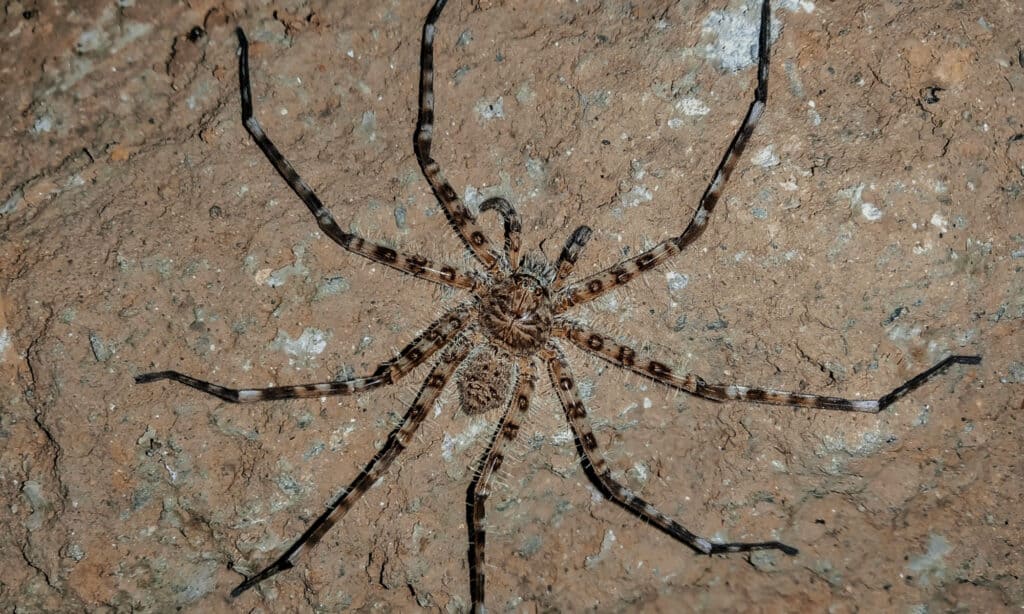
The giant huntsman spider typically lives under decaying wood. When it spots its prey, it can move up to 3 feet in a second.
©Nikhil Guhagarkar/Shutterstock.com
If you are afraid of spiders, then you may be asking, “What is the biggest spider in the world?” To determine which is the biggest, there are two factors to take into consideration.
First, a spider’s body weight could determine which is the biggest. Or, you could gauge it by the body length. So based on either criteria, you could name two different spiders as “the biggest spider in the world.”
Where do the biggest spiders in the world live? The answer is that they live in many diverse locations. This list will tell you more about them, their size, and where they live.
For our intents and purposes, the leg-span measurement at maturity has been used to determine the placement of the biggest spider in the world.
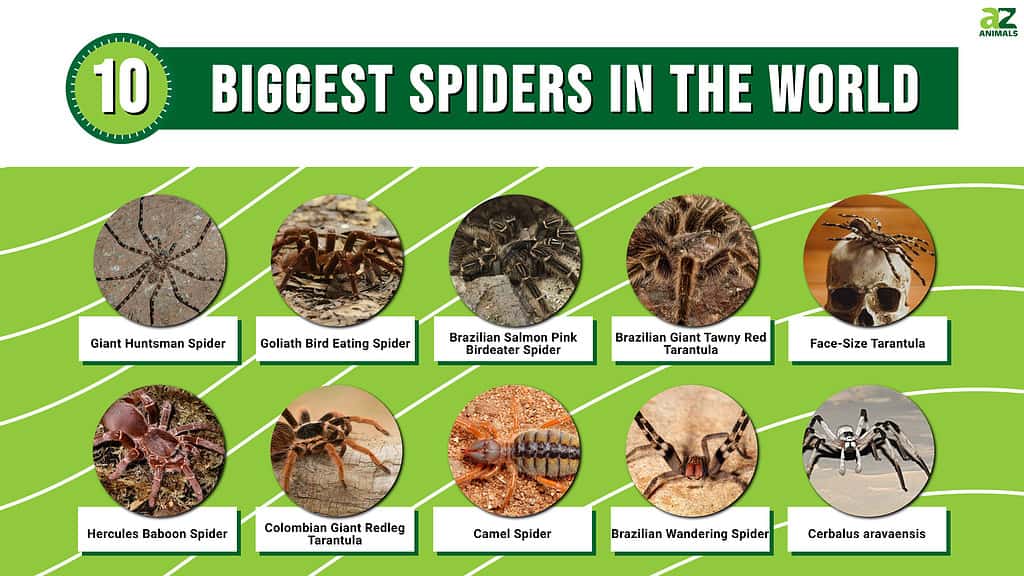
10. Cerbalus aravaensis – 5.5-inch Leg Span
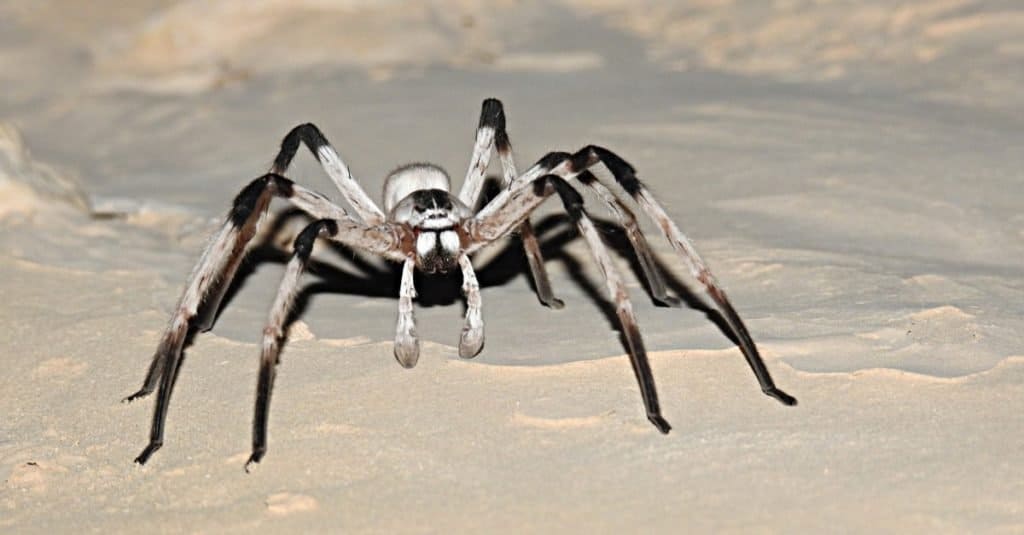
The
Cerbalus aravaensislives in an underground den with a “lifting door” made of glued sand particles so the den remains camouflaged.
©Dan Shachar/Shutterstock.com
If you travel to the sand dunes of the Arava Valley of Israel and Jordan, watch for the Cerbalus aravaensis spider. It is the biggest spider known to the area. The Cerbalus aravaensis isn’t the biggest spider in the world, but it’s close. The spider is hard to miss because its 5.5-inch leg span makes it hard to miss an object crawling that its size. Salt mining and agricultural land conversion threaten its habitat.
This nocturnal arthropod builds homes in the sand, where it hides from its predators. These homes have trap-like doors to protect these spiders which are some of the largest spiders in the world.
9. Brazilian Wandering Spider – 5.9-inch Leg Span
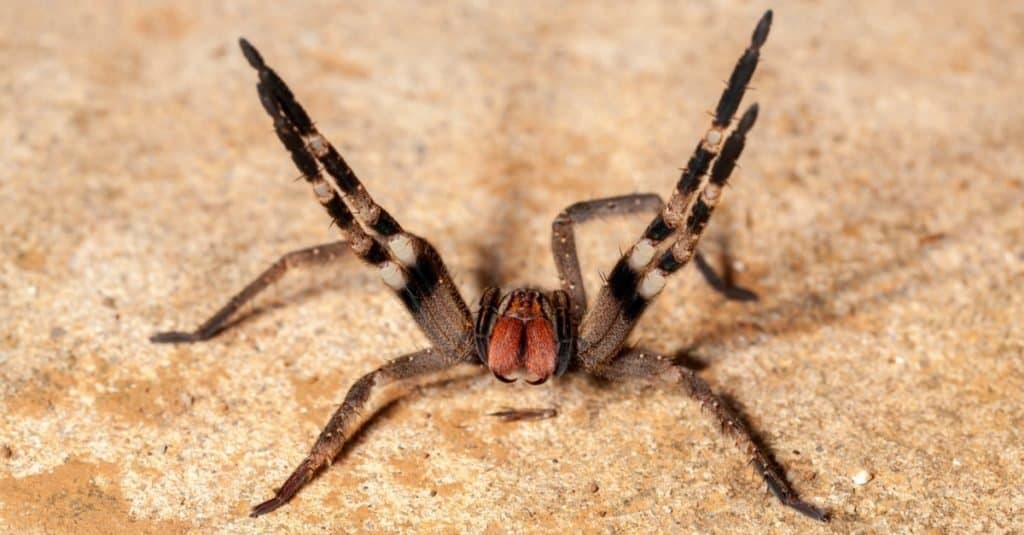
The Brazilian Wandering Spider is called “armed spiders” in Portuguese because their venom is a powerful weapon.
©Tacio Philip Sansonovski/Shutterstock.com
The Brazilian wandering spider is the ninth biggest spider in the world, also called the armed spider or banana spider has a 5.9-inch leg span. The Guinness Book of World Records has classified this arthropod as one of the most venomous in the world, but it isn’t quite the largest spider in the world.
There are at least eight subspecies of this spider that mainly live in Brazil but also in Costa Rica to Argentina.
It is usually brown, and it may have a black spot on its belly. These are some of the largest hairy. The hairs on these big spiders often make the size of this option look even bigger. These nocturnal arthropods who live under logs dine on insects, small amphibians, reptiles, and mice.
8. Camel Spider – 6-inch Leg Span
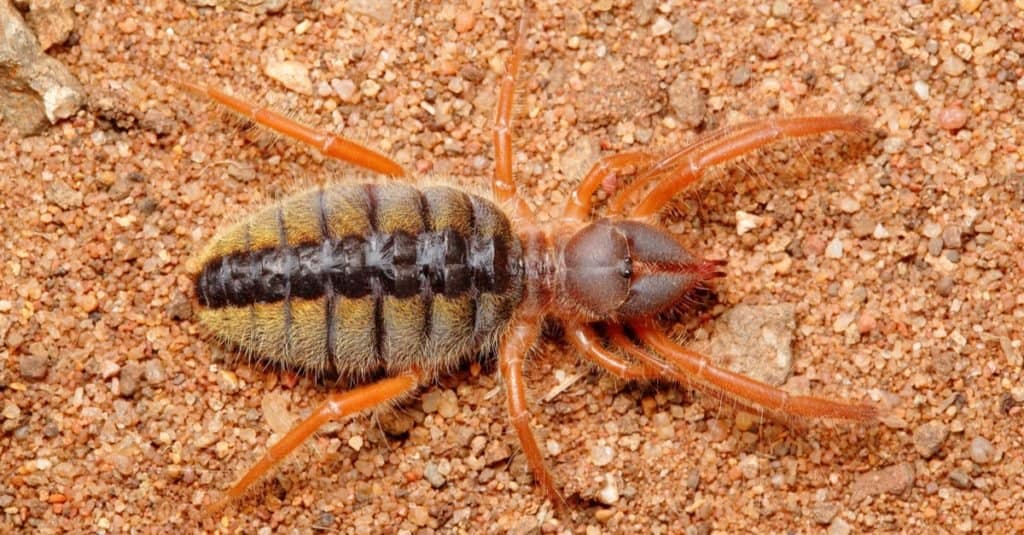
Camel spiders are not deadly to humans (though their bite is painful), but they are vicious predators that eat rodents and small birds.
©Ondrej Michalek/Shutterstock.com
The light tan camel spider has about a 6-inch leg span and is one of the biggest spiders. It is one of the fastest spiders as it often moves at speeds approaching 10 miles per hour.
These arthropods sometimes emit a buzzing sound, but they have no venom. They aren’t the largest spiders in the world, but these big spiders are eye-catching.
These spiders living in Iran and Iraq feast on insects, rodents, lizards, and small birds. The jaws of these spiders can make up to 33% of their total body length, and they use them to clamp down on their prey.
You may have heard that these giant spiders will chase people. The fact is, they aren’t chasing you. These spiders like the shade. These spiders are chasing your shadow, not you. Camel spiders have a lifespan of about a year and only have two eyes.
Learn more about camel spiders.
7. Colombian Giant Redleg Tarantula – 7-inch Leg Span
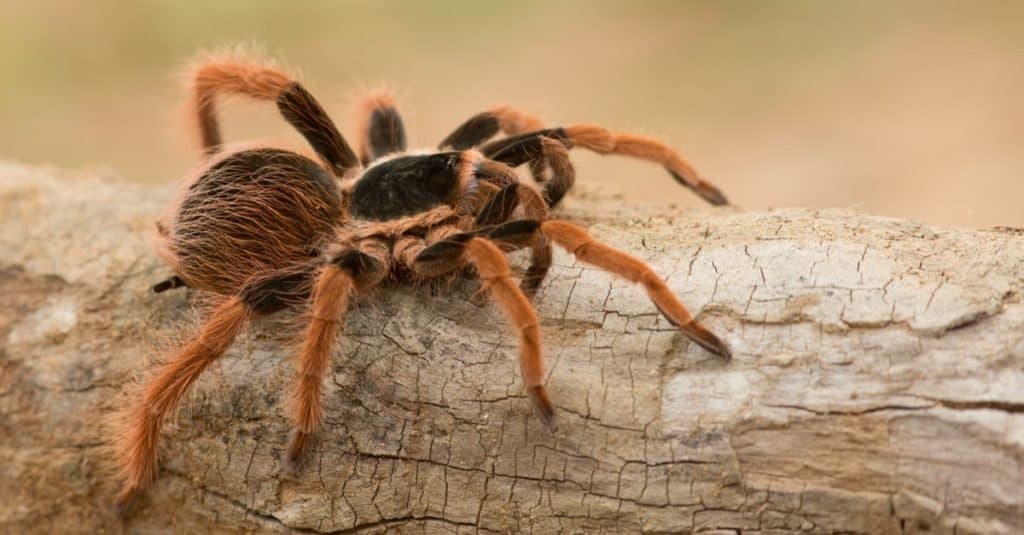
The Columbian giant redleg spider is considered to be one of the most beautiful spiders in the world.
©Milan Zygmunt/Shutterstock.com
The Columbian giant redleg spider has about a 7-inch leg span. This spider lives in Colombia and parts of Brazil. It has bright reddish-orange hairs on its legs.
While males live to be about 4 years old, females often live to be 20 years old. This spider species is huge, but it still isn’t the largest spider in the world.
This nocturnal arthropod is very nervous. It will spin and start bobbing up and down. If the threat does not leave, it will use the hidden thorny spikes on its back legs in the direction of the danger.
These big spiders will finally use their fangs to bite their victim.
6. Hercules Baboon Spider – 7.9-inch Leg Span
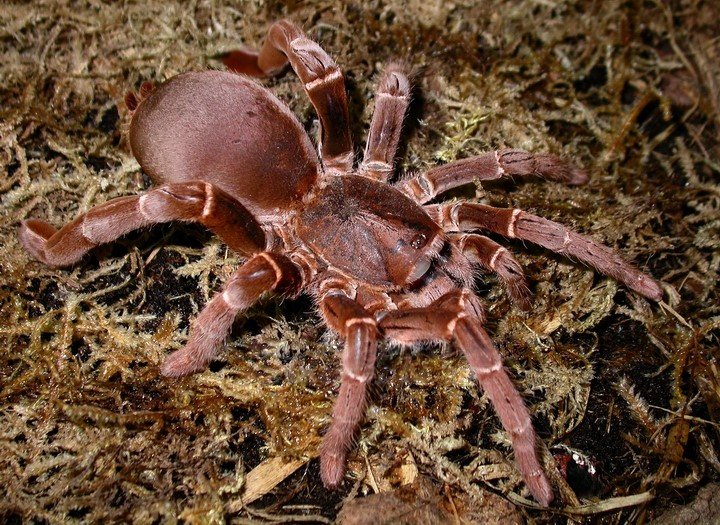
Hercules
Baboon Spider’s common name refers to the fact that baboons often eat them.
©Www.universoaracnido.com / CC BY-SA 2.5 – License
Biologists have only found the Hercules baboon spider one time, but they collected it in Nigeria over 100 years ago. You can see it in London’s Natural History Museum. This East African arthropod takes its name from the fact that its rusty-brown body looks like a baboon. It may be the heaviest spider ever captured.
As one of the scarier big spider species in the animal kingdom, this Hercules Baboon Spider is in fact a venomous tarantula that was found mainly in Africa. This spider was once known to make burrows in grasslands and dry scrubs. They were known to make deep shelters to protect themselves from the harsh weather.
They were said to prey on insects, bugs, and other small spiders. They aren’t the biggest spiders in the world, but you wouldn’t want to run into one if you have a spider phobia.
5. Face-Size Tarantula – 8-inch Leg Span
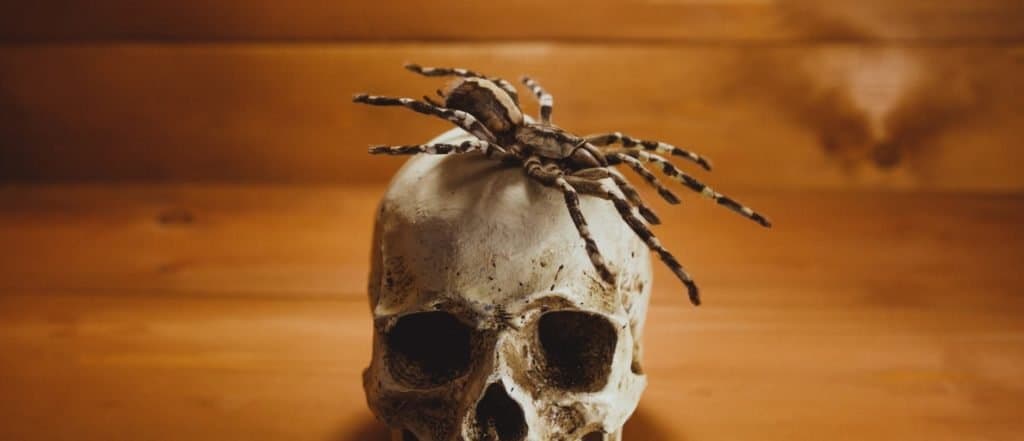
Tarantulas are quite docile and rarely bite people.
©Anna55555/Shutterstock.com
The face-size tarantula has about an 8-inch leg span. This spider found in Sri Lanka and India lives in old buildings and decaying wood. Its diet consists of birds, lizards, rodents, and snakes that are often bigger than this length.
This tarantula has daffodil-yellow banding on its legs and a pink band around its body. Scientists did not discover it until 2012, and biologists think there may be even more unknown arthropod species living in the northern area of Sri Lanka. These big spiders have a massive leg span but still isn’t the largest spider in the world.
Still, it is dangerous for them to explore there because of the ongoing conflict.
4. Brazilian Giant Tawny Red Tarantula – 10-inch Leg Span
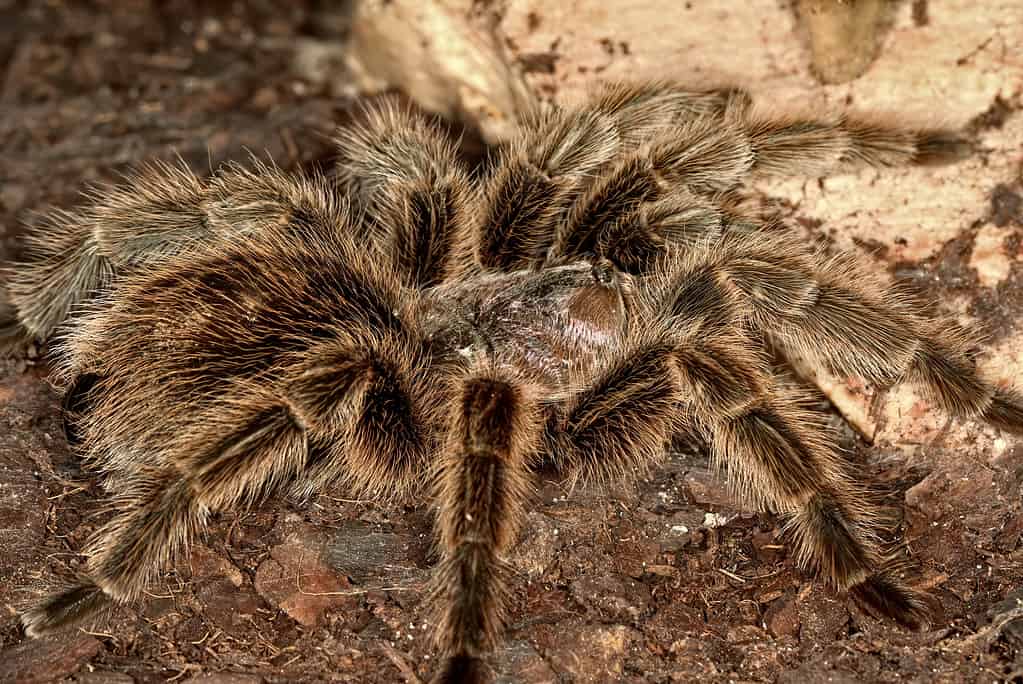
The fourth biggest spider in the world is the massive Brazilian giant tawny red tarantula.
©Russell Marshall/Shutterstock.com
The fourth biggest spider in the world is the Brazilian giant tawny red tarantula, which lives in Brazil, Uruguay, Paraguay, and Argentina. The fourth leg of this brown spider can be up to 2.3 inches long while its whole body is only 2.5 inches long.
Like its other cousins in the Tarantula family, this arachnid’s abdomen is lined with hairy darts to ward off predators. The kind it possesses is capable of giving foes of both the invertebrate and vertebrate variety pause and can be especially potent against mammalian attackers.
3. Brazilian Salmon Pink Birdeater Spider – 10-inch Leg Span
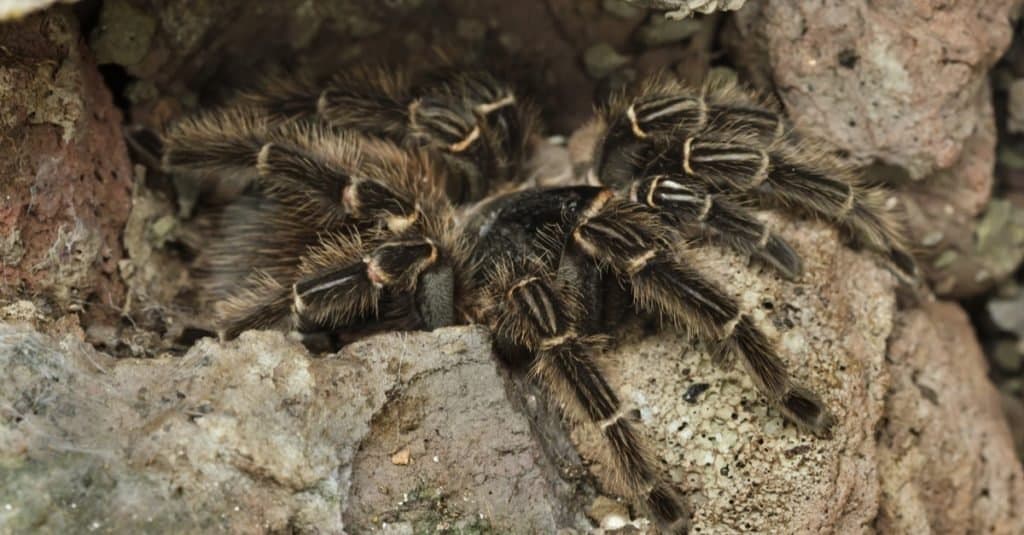
The Brazilian salmon pink birdeater spider is considered to be semi-aggressive and active and is for intermediate to experienced keepers.
©Vladimir Wrangel/Shutterstock.com
The Brazilian salmon pink birdeater spider has a 10-inch leg span but isn’t the largest spider in the world. As the name suggests, this spider lives in Brazil, but you may also see it in Argentina and Paraguay. It has a dark brown body with bright salmon blotches on it making its length look even more intimidating.
First, this spider uses its fangs to inject venom into its prey. This venom kills the prey. Then, it releases fluid to digest the prey partially. While it is not listed as endangered, its Atlantic Forest habitat is constantly shrinking because of human development.
2. Goliath Bird Eating Spider – 11-inch Leg Span

The Goliath birdeater is the biggest spider in the world by weight and body size.
©juerginho/Shutterstock.com
The goliath bird-eating spider is the largest spider in the world by mass and has an 11-inch leg span. Scientists discovered the first one in 1804. This brown-to-light-brown arthropod lives in Suriname, Guyana, French Guiana, Venezuela, and Brazil. This nocturnal arthropod lives mainly in the Amazon rainforest.
It weighs between five and six ounces. While people have observed a few of the largest ones eating small birds, like hummingbirds, most of their diet consists of insects and small terrestrial vertebrates. You will not usually see one dining because they drag their prey back to their hidden nests before eating.
1. Giant Huntsman Spider – 12-inch Leg Span
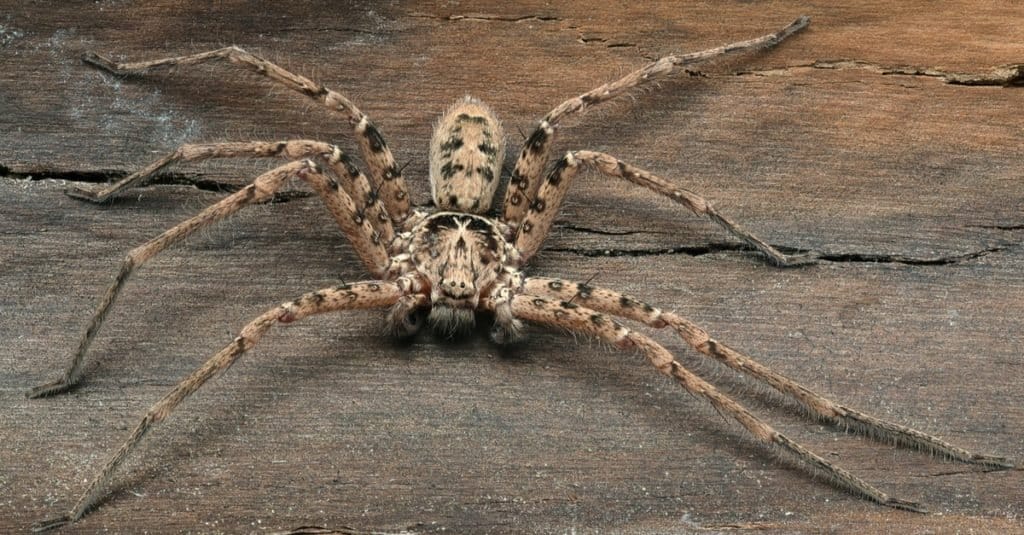
The world’s biggest spider, the Giant
Huntsman Spider
, are not harmless to human but will bite if provoked.
©iSKYDANCER/Shutterstock.com
The largest spider in the world by leg span is the giant huntsman spider coming in at 12 inches. It does not build a spiderweb to catch its prey. Instead, it hunts its prey down.
While you can see huntsman spiders at many different worldwide locations, the giant huntsman arthropod only lives in caves in Laos. This arthropod discovered in 2001 has crablike legs with twisted joints, so they move like a crab.
This arthropod typically lives under decaying wood. When it spots its prey, it can move up to 3 feet in a second. These spiders have an elaborate mating ritual.
Then, the female lays up to 200 eggs in a sack-like cocoon that she guards fiercely. After three weeks, when it is time for the spiderlings to hatch, she will help tear the cocoon open. She may stay with the spiderlings for several weeks.
Even if you are generally not afraid of spiders, these 10 are big enough to scare you. They are amazing arthropods that need you to help protect their habitat. Even though you probably don’t want any of these arachnids anywhere near you understandably, they are each a crucial and fascinating piece in their own ecosystem.
Bonus: Indian Ornamental Tree Spider
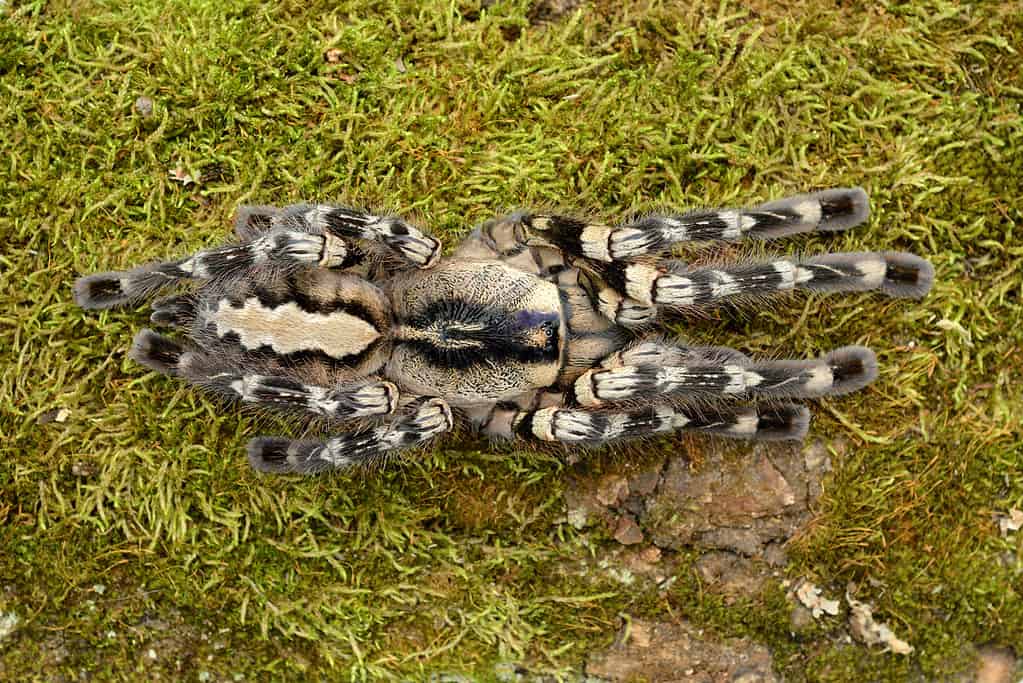
The Indian ornamental tree spider, or simply Indian ornamental, is a common name for this spider.
©D. Kucharski K. Kucharska/Shutterstock.com
This spider is commonly known as the Indian ornamental tree spider or simply Indian ornamental, and it’s a favorite among amateur collectors due to its popularity. Its leg span can reach more than 7 inches (18 cm).
Female individuals of the species generally have a lifespan of 11 to 12 years, with a few exceptional cases of up to 15 years. On the other hand, males have a shorter lifespan, living for about 3 to 4 years.
Male and female P. metallica spiders have the same average adult size, which ranges from 6 to 8 inches.
Evolution and Origins of Spiders
The evolution and origins of spiders can be traced back to the Late Devonian period, about 380 million years ago, where fossil evidence suggests the existence of ancient arachnids.
Over time, these early arachnids developed unique characteristics, such as silk production and the ability to spin webs, which allowed them to diversify and occupy a wide range of environments.
Spiders likely evolved from a common ancestor with other arachnid groups, such as scorpions and mites, and have since undergone significant adaptations to their anatomy, behavior, and life history to become one of the most successful groups of predators on the planet.
Today, there are over 48,000 species of spiders, each with its own unique adaptations and ecological roles. Spiders play important roles in many ecosystems as predators of insects and other small animals and as providers of silk for various uses, including the construction of webs for hunting, protection, and reproduction.
Top 10 Biggest Spiders in the World
Here are the top 10 biggest spiders on Earth:
| Rank | Spider | Leg Span |
|---|---|---|
| #1 | Giant Huntsman Spider | 12 in |
| #2 | Goliath Bird Eating Spider | 11 in |
| #3 | Brazilian Salmon Pink Birdeater Spider | 10 in |
| #4 | Brazilian Giant Tawny Red Tarantula | 10 in |
| #5 | Face-Size Tarantula | 8 in |
| #6 | Hercules Baboon Spider | 7.9 in |
| #7 | Colombian Giant Redleg Tarantula | 7 in |
| #8 | Camel Spider | 6 in |
| #9 | Brazilian Wandering Spider | 5.9 in |
| #10 | Cerbalus aravaensis | 5.5 in |
| Bonus | Indian Ornamental Tree Spider | 7 in |
Honorable Mention: Other Big Spiders
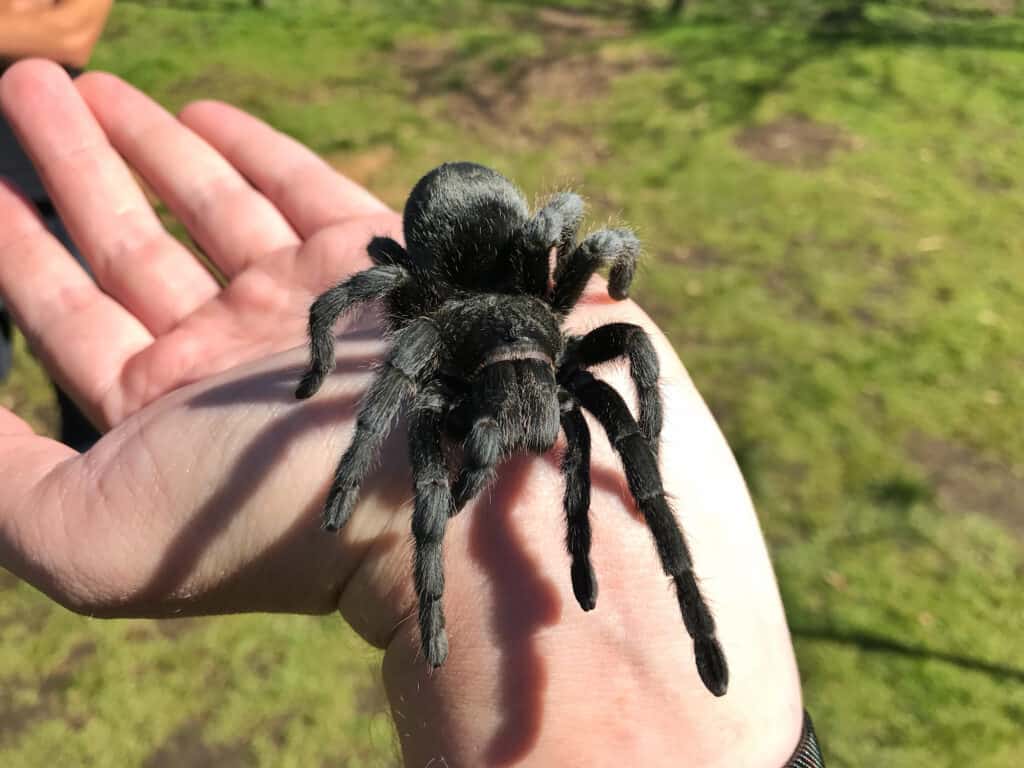
The exotic pet trade monitors their numbers and tries to regulate the export of the Brazilian black tarantula.
©iStock.com/Willem Van Zyl
There are over 50,000 different kinds of spiders that can be found throughout the world. Some are small, like Patu marplesi, a species that is endemic to Samoa and only reaches a size of 0.018 inches, while many are large like the ones on our list can attest to. Average legspans may preclude these species from being in the top ten, but their potential for maximum growth makes them impressive contenders.
- King Baboon Spider (Pelinobius muticus) – this arachnid belongs to the genus Pelinobius, found in East Africa, of which there is only one species. It is the largest spider in Africa and can have a leg span of up to 7.87 inches in length. They are known to be a bit more aggressive, or defensive than many other tarantulas and aren’t thought to make a good pet for beginners.
- Chaco Golden-knee (Grammostola pulchripes) – this spider was formerly known as Grammostola aureostriata and is another tarantula that is thought to be one of the largest in the world. It can reach sizes of up to 8.5 inches (of which 7 or 8 inches is its legspan). Endemic to Paraguay and Argentina, it is an arachnid that is very calm and docile, which lends to its popularity as a pet.
- Poecilotheria rajaei – this spider belongs to the genus Poecilotheria, native to Sri Lanka and India, and is named after Michael Rajakumar Purajah, a local police inspector who guided the team of research scientists when they were searching for specimens. It was first discovered in 2009 and has a legspan that can reach up to eight inches.
- Brazilian Black Tarantula (Grammostola pulchra) – this spider has a beautiful black, velvety color and due to its popularity, has been given the nickname ‘the black lab of spiders’. It is similar to the salmon-pink bird-eater in that they are both found in South America and are considered the most popular ‘starter’ spiders to keep as pets. Most of them are thought to be very docile and hardy, and this particular arachnid can have a total size of up to eight inches (of which six are its legspan), although it averages sizes between six and seven inches.
The photo featured at the top of this post is © SIMON SHIM/Shutterstock.com
Thank you for reading! Have some feedback for us? Contact the AZ Animals editorial team.






